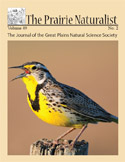Great Plains Natural Science Society
Date of this Version
6-2019
Document Type
Article
Citation
The Prairie Naturalist 51:3-16; 2019
Abstract
Annual angler harvest of white bass (Morone chrysops) increased from 1985–2005 in Lake Oahe and Lake Sharpe, two mainstem Missouri River reservoirs in South Dakota. In 2006, harvest rates dropped appreciably in both reservoirs and remained low through 2015. It is hypothesized that a confirmed 2005 columnaris disease outbreak led to reduced annual angler harvest of white bass from both reservoirs. Mean annual angler harvest prior to the outbreak (1985–2005) in Lake Oahe decreased 65% and in Lake Sharpe decreased 57% post outbreak (2006–2015). To assess potential causes of sustained decreased adult white bass abundance in the reservoirs, we examined relationships among environmental (i.e., temperature, precipitation, water elevation, inflow) and biological factors (i.e., prey abundance, potential competitor abundance) with both age-0 and adult (>100 mm total length) white bass relative abundance before and after the columnaris disease outbreak. Prior to the outbreak, age-0 and adult white bass abundance was related to biological variables (i.e., age-0 fish abundance, adult walleye abundance and adult predator abundance) on Lake Oahe and Lake Sharpe. Following the outbreak, age-0 and adult white bass abundance was related to environmental variables (i.e., January gauge height, precipitation and temperature, April and July gauge height and precipitation) in both reservoirs. We hypothesize that since the columnaris disease outbreak reduced white bass abundance, environmental and biological factors have changed roles in affecting age-0 and adult white bass abundance (and angler harvest) in both reservoirs. Although these relationships are not necessarily causes of reduced abundance, we believe they can aid in management of white bass populations by allowing prioritization of biological and environmental factors related to age-0 and adult white bass abundance after columnaris disease-related die-offs.
Included in
Biodiversity Commons, Botany Commons, Ecology and Evolutionary Biology Commons, Natural Resources and Conservation Commons, Systems Biology Commons, Weed Science Commons


Comments
Copyright © 2019 The Great Plains Natural Science Society